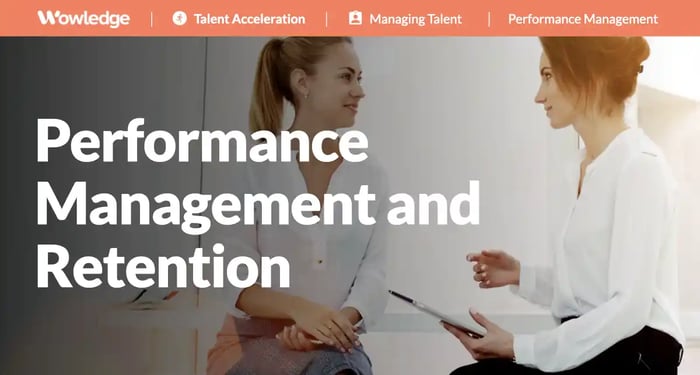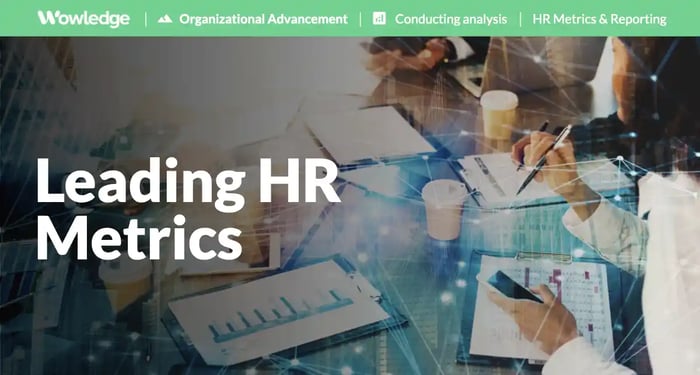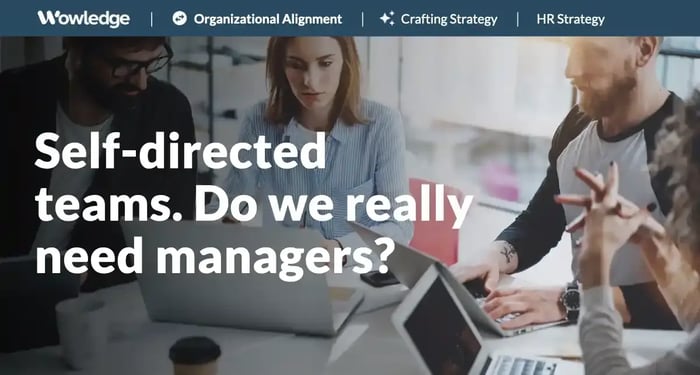Employees and leaders hate performance evaluations. Much has been written about this over the past 10 years or more, yet the pain continues in most organizations. While the employee (and manager) experience (EX) is clearly poor and needs to be a priority, the core question we should ask is to what extent the problem negatively impacts the most critical talent and business outcomes. At Wowledge, our experts continue to “bang the drum” about the criticality of looking at and measuring the impact on outcomes vs. process efficiencies in HR. From that perspective, looking into the effects of quality performance management design and execution on desired talent and business outcomes is essential. The link between performance management and retention is particularly important given the ongoing labor shortages and employee turnover challenges facing employers across industries and (global) geographies.
The data from research supports the notion that performance management as a core talent process continues to be broken. For example, a recent article in the Washington Post reported that 66% of the employees were strongly dissatisfied with their performance evaluations, and 65% of those surveyed employees felt that the appraisals were irrelevant to the work they performed and the contributions they made. It is not only the workers but their managers and HR leaders – one study reported that 95% of managers were dissatisfied with the process, and just less than 90% of HR leaders indicated that their process generates inaccurate performance data. The fact is that neither employees nor their organizational leaders trust the process to provide useful or trustworthy information that is supposed to guide ever-improving performance across enterprises.
The purpose of performance management
Performance management is a core business process designed to guide individual employee’s work efforts, ensuring that those are aligned with the needs and objectives of the business, the assigned function, and the department/team. The process, however, encompasses a broader set of elements that provide longer-term guidance for the employee by including goal setting, performance feedback, professional development, and task/project assignments. Byproducts of a well-functioning process include a bonding (or “engagement”) to and alignment with the larger organization’s mission, values, and purpose. Performance management and retention are inextricably linked to the employee value proposition.
When designed and deployed effectively, performance management and retention go hand-in-hand. Such a process drives employee engagement and retention by supporting successful job performance, connection with and trust in one’s manager, and personal growth through development and advancement. It is conceived as a process that optimizes human-to-human guidance and coaching from a more experienced and well-versed expert (the manager) who serves as an omniscient/”all-seeing” presence in the employee’s work life who can provide business context and technical reasons for certain task requirements, work methods, timeframes, and needed outcomes. However, regardless of how well the process is supported and enabled by technology, training, tools, job aids, etc., it is still basically a human endeavor, wide open to issues of bias, misperception, interpersonal dynamics, and shortcomings in direct observation and data collection related to daily work performance.
As a result, despite being well-intended, the process is poorly designed and executed in many organizations, leading to breakdowns in the performance management and retention equation.
Breaking down the challenges driving the ineffectiveness of the process
Despite the widely publicized and reported advances towards significant improvements in the performance management process (eliminations of ratings, the addition of frequent “check-ins,” dropping of annual reviews, etc.) and reports that as many as three out of every four companies have made significant changes to their process, data suggests that those efforts are not improving the experience for employees or managers. For example, Gallup has reported that 47% of employees get feedback only a few times per year or less. Similarly, according to SHRM, 71% of companies still report that they provide formal performance reviews on an annual basis.
The impact of the process is key here – if people don’t like them while they effectively drive improved performance, then why pursue major upgrades in the first place? As it turns out, Gallup found that the end-of-the-year assessments and discussions often leave employees so unhappy that they worsen subsequent performance in almost one out of three (1/3) cases. Part of the issue relates to the actual employee experience, where a lack of ongoing communication and coaching has led to surprises that were not anticipated. One study found, for example, that 62% of employees “felt blindsided” by the feedback they received in performance reviews. And 40% of employees reported disengagement from their work when little to no feedback was provided. The impact? Employees start looking for a new job where they can (hopefully) get better coaching, more useful feedback, or a better overall sense of where they contribute and how they can enhance their standing in the organization’s eyes. It's a good example of how performance management and retention work together (for the worse). This is particularly concerning with the generation that is now the dominant population segment in the workforce, the Millennials, who seem to be especially dissatisfied with the classic process. A report from Adobe in 2017 found that after completing the annual review cycle, 47% of those workers started looking for a new job.
The reasons for these issues become clearer when one breaks down the steps and planned or expected outcomes of a well-designed and executed process. The fact is that in many ways, companies are failing to meet the very purposes of the processes’ existence – to clarify role expectations and work output objectives, align the employee with larger corporate values and purpose, develop the employee skills base, and make them feel connected and appreciated to the company and its culture. Unfortunately, the research demonstrates that those purposes are not being met, negatively impacting performance management and retention. Gallup has found that the biggest declines in the key elements of employee engagement are due to fewer employees who are extremely satisfied with their:
- Clarity of expectations.
- Connection to the mission or purpose of the company.
- Opportunities to learn and grow.
- Opportunities to do what employees do best.
- Feeling cared about at work
Each of these is a direct byproduct of a quality performance evaluation process – one that is focused on goal setting, feedback, development, deployment, and connection to the company mission. With the strong connection between engagement and retention, it has become evident how employees’ performance and contributions are assessed and communicated drives their willingness to stay with an organization and continue contributing to its success. Understanding the links between performance management and retention is critical.
The case for improving performance management to increase retention
Objective data supports the notion that improving the process and delivery of assessing performance can yield significant organizational outcomes. Increasing the frequency of feedback alone has been shown to improve talent outcomes. For example, companies implementing continuous (e.g., weekly, bi-weekly) coaching and feedback are 39% better at attracting talent and enjoy 44% higher retention rates than others who have not done the same. Gallup reports that weekly manager feedback leads to employees who are 2.7 times more likely to report high engagement levels.
SHRM has found that employees who are actively involved in setting their performance goals with their supervisors are 3.6 times more likely to report high engagement (although it does caution that only 30% of surveyed employees stated that their manager made goal-setting a collaborative exercise). The key to both of these examples is employee participation in the performance evaluation process. Without that participation in a traditionally top-down process, employees are deprived of a sense of empowerment, which helps break down the connection between performance management and retention. That can create a sense in the worker that their input is inconsequential, ultimately a major reason for turnover.

Key elements of a great performance management process that can drive improved retention
The critical elements of a successful process are those that actively demonstrate respect for the employee, provide clarity about expectations and standards, assess performance fairly and objectively with standardized criteria, acknowledge strengths and successes, focus constructively on opportunities for improvement, and guide the employee towards professional success and growth. And built into this is a need to address the human condition – through the manager’s active listening, soliciting employee feedback, acknowledging perceptions, and considering their preferences and aspirations. Creating strong ties between performance management and retention depends upon several key elements.
Goal setting
- Develop goals in two primary buckets – performance and developmental. Performance goals should always consider the individual’s strengths, role tenure, and ability level. The concept of a “a stretch but achievable” goal will differ from one individual to another. It should be developed in a manner that allows each employee to achieve their work goals in line with business objectives. Developmental goals should always be identified and assigned based on the individual and organization's desired career progression and related skill development needs.
- Link goals as directly as possible to those of the larger organization. Through this, everyone is able to have a “line of sight” from their work requirements to the purpose and goals of the larger department, function, business unit, and corporation. This helps bring meaningfulness to each person’s day-to-day efforts and contributions.
- Define and communicate the criteria against which the goal will be assessed so the employee can track their progress and get a clear sense of what is expected and how it will be fairly evaluated.
- Be flexible with goals throughout the performance period – being prepared to change the goal as more pressing issues or circumstances arise communicates the value of agility and resourcefulness to the employee. It addresses the realities of managing people, processes, and products/services by showing a willingness to “pivot” and engage with the employee in the business rationale for any shifts in priorities.
Coaching and conversations
- Provide frequent and continuous conversations to create an environment of shared understanding of what is expected, the challenges the employees face as they pursue those expectations, and the best ways to overcome hurdles. Core to this is direct and timely feedback that builds trust and a sense that the manager is supportive and has the employee’s best interests in mind.
- Create a dialogue with the employee by asking for their input, ideas, and challenges faced. Establish joint ownership of the process to build an employee’s sense of being heard, valued for their inputs and insights, and respected as a valued contributor.
- Guide the employee through shared brainstorming about how they can handle difficulties and barriers, provide observations and insights to help with such assessment, and come to a shared agreement about the next steps.
Performance feedback
- Seek to identify performance issues early, always gaining the employee’s perspective, providing guidance on addressing those, and improving the likelihood of success. Track improvement commitments and follow up on progress in subsequent meetings.
- Collect brief notes on each conversation in real-time to support fair and equitable consolidation for subsequent performance ratings and meet documentation requirements for rewards and improvement purposes. Take notes on employee strengths, skill deficits, goal adjustments, and commitments or agreements made.
- Provide recognition in the moment to reinforce such efforts and outcomes. Employees respond well to simple “pats on the back” or IMs/emails with others copied to celebrate wins and thank them for efforts that helped meet goals or kudos from customers, suppliers, and/or executives. Such actions build faith in employees that they are on the right path, performing to/beyond expectations and generating a sense of pride, value, and encouragement that, in turn, builds engagement.
Tailor development plans and activities
- Identify opportunities to grow employee skill sets relevant to current and future/aspirational roles. Regularly discuss upcoming programs or resources that fit with skill development needs and agree on the value and motivation to take advantage of those.
- Create or identify experiences, projects, and tasks that can be taken on to stretch or further develop and acquire skills. Solicit suggestions from employees to identify opportunities in which they are especially interested.
- Do the homework to understand each employee’s skills, strengths, work style, preferences, and ambitions to provide a more tailored direction to employee development paths.
- Have periodic (and planned/scheduled) career planning discussions to identify the types of roles the person aspires to. Provide thoughts on the types of roles into which they might grow. Offer feedback on their suggestions without demoralizing them with feedback that their ambitions are unrealistic. Instead, refer them to role incumbents or leaders in the organization who can offer a realistic insight into the requirements and demands of a given role.
- Link successful task completion to further skill-developing opportunities. Continue to test each employee's skill boundaries while not penalizing them for failure or sub-standard performance in a side project designed to test their learning ability.

Establishing a supportive performance management ecosystem to increase retention
Individual managers can only do so much on their own when it comes to retaining employees. While each manager’s skill is core to the employee experience, enterprise-wide approaches are required to reinforce and support a solid and meaningful culture that engages and rewards employees for staying. Quality performance management and retention are keyed by compassionate treatment and the extent to which an organization and its managers meet employee expectations. Research by the Pew Research Center suggests key reasons employees leave their jobs include lack of advancement opportunities, feeling disrespected at work, lack of flexibility, lack of benefits, etc. Most of those reasons are addressable and should be attended to by HR and leadership to build foundations for a great employment experience that drives longer tenures. Specific actions that can address the performance management and retention issue at an enterprise level include:
1. Leadership commitment and championing
Bringing leaders directly into the development and ownership of the retention battle requires a formal governance model and structure. With defined roles, responsibilities, and access to data and resources, top leaders should meet regularly (e.g., quarterly) to review retention and related (e.g., engagement, employee demographics, turnover, exit interviews, post-performance process surveys) data to assess the need for improvement strategies. They should be called upon to monitor their organizations down to the supervisory level to hold managers accountable for quality results and positive employee feedback on coaching, development, and career guidance. They should be called upon to be vocal advocates for quality coaching and act as role models by activating the same protocols and methods on their managers that they expect others to do.
2. Train and develop managers
On a continuing basis, all leaders and managers should receive training and coaching on becoming better guides in the performance process. Leverage group coaching, for example, where similarly leveled leaders discuss challenges and help each other develop improved skills at handling the full range of performance coaching, feedback, and development discussions.
3. Measure the manager's behavior so it matters
Gather ongoing pulse survey data from employees to evaluate managers' skill and competency at performing the necessary elements of productive and constructive performance management throughout the year, not only (but certainly including) after formal evaluations and ratings are approved and communicated.
4. Collect performance data from multiple sources
Help managers at all levels bring greater objectivity into the evaluation process by collecting multi-source performance data on each employee. Solicit feedback using mini-reviews from other (e.g., project) managers, peers, and customers to provide a more broadly-based set of observations to the manager. Consider adopting a formal performance calibration process across employees in the same or similar roles, with managers comparing and contrasting performance goals, challenges faced, and level of sophistication of work methods used to more fairly assess and compare performance relative to peers.
5. Focus on the employee in conversations
Promote directness and honesty in these conversations, helping the employee understand the current assessment. Create a script of questions managers can ask to create a relationship where employee input is standard and a two-way conversation is expected. Managers should always ask employees what is going well, what barriers exist, what resources are needed, and where they need coaching or help. The key is to focus on what the employee needs to do to achieve their goals, perform outstanding work, and achieve their ambitions.
The bottom line
Performance management, especially when well-designed and -executed, can drive a sense of meaningfulness, belonging, and well-being. When a manager engages the employee in regular conversations that are clear and collaborative, employees can operate with confidence that they are respected for their ability to contribute, understand how their work ties to larger goals, are appreciated through regular “well-dones” and guided through both short-term skills and career development planning processes that provide a longer-term vision of working in the organization. And equally important, through regular discussions, coaching, and mentoring tailored to their strengths, skills, and aspirations, employees can feel connected to their manager and the organization. By considering the relationship between performance management and retention, turnover reduction can be improved. By supporting individual performance enhancement, employees can enjoy positive experiences. A combination of pride in their work and contributions through feedback and recognition, along with a sense of belonging and value to the organization, creates engagement and, ultimately, longer-term retention.
Relevant Practices & Tools
Core Performance Management Practices to Set Expectations and Provide Effective Feedback. >
Performance management engages employees and their managers in the annual process of planning key work efforts and developmental activities, evaluating the extent... more »
Cascading and Updating Strategic Goals that are Aligned with Organizational Objectives. >
Creating a formal flow of goals from top executives down to the lowest level employees ensures an alignment of work efforts and objectives from the top to the bottom of the organization... more »
Providing Feedback to Support Employee Growth, Productivity, and Improvement. >
Providing feedback to employees can be challenging for functional managers and employees alike. There is an art to discussing a year’s worth of work with an employee... more »
Providing Frequent Coaching and Feedback to Adapt and Adjust Performance Throughout the Year. >
Coaching & Mentoring is an employee development activity that, in the context of performance management, involves a manager providing feedback and guidance on an ongoing basis... more »
The Managers Guide to Performance Conversations Tool: Conduct and Record Regularly Occurring Manager-Employee Performance Conversations. >
A guide and template for leading regular manager-employee conversations regarding performance over a short (e.g., 1-4 weeks) period of time... more »
About Wowledge
Wowledge is the expert-driven platform for lean teams building strategic HR programs. Members enjoy access to up-to-date best practices, step-by-step guides, tools, templates, and insights to accelerate the design and implementation of all key HR programs and processes.
Since each organization has unique characteristics, needs, and aspirations, Wowledge's practices are developed utilizing an exclusive stage-based approach – from Core to Advanced to Emerging – that reflects distinct levels of sophistication to meet our members where they are.
Build strategic HR programs with refreshingly easy-to-follow best practices.
Get started for FREE! Learn more.










